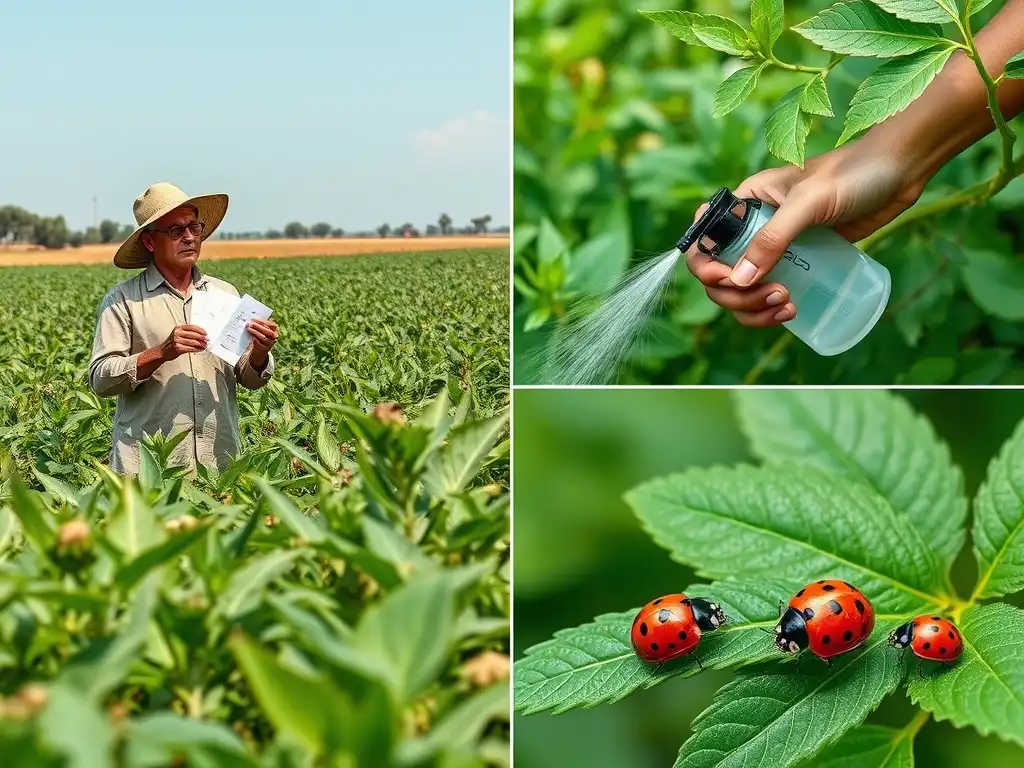All blog posts
TopReferralCode.online is your trusted hub for the latest, verified referral codes, promo codes and coupons across ecommerce, food‑delivery, travel and more. Save up to 50% on every purchase—discover exclusive deals you won’t find anywhere else.
IVIM Coupon Codes [June 2025] – Save Big on Personalized Health Programs
May 10, 2025 | by Aria Thorne
Joker Com Coupon Code First Order : 99% OFF Domains First Order! (Limited Time)
May 10, 2025 | by Aria Thorne
TouchTunes Promo Codes 2025: Score Free Songs & Epic Rewards Now!
May 8, 2025 | by Aria Thorne
Effectiveness and Recommended Doses of Pesticides and Disease Control Agents
April 3, 2025 | by Aria Thorne
Weed Management in Crops: Integrated Control Strategies
April 3, 2025 | by Aria Thorne
Micronutrient Deficiency Symptoms and Safe Pest Control in Crops
April 3, 2025 | by Aria Thorne
Crop Pests and Diseases: Integrated Control Strategies for Sustainable Agriculture
April 3, 2025 | by Aria Thorne
Beneficial Insects and Integrated Pest Management: A Sustainable Path to Crop Protection
April 3, 2025 | by Aria Thorne
Integrated Crop Protection: A Sustainable Approach to Modern Agriculture
April 3, 2025 | by Aria Thorne
Embarking on a health and wellness journey can be transformative, but costs can add up. Ivim Health offers personalized programs. including telehealth consultations, medication management, and app-based support, to help you achieve your goals. To make these services more affordable, Ivim Health provides Coupon Codes that can significantly reduce your expenses. This article lists the latest Ivim coupon codes for June 2025. explains how to use them, and dives into what makes Ivim Health a standout choice for health-conscious individuals. Whether you’re exploring weight management or seeking expert guidance. these discounts can help you start your journey on the right foot.
Latest Ivim Coupon Codes
Below are the most up-to-date Ivim Health coupon codes, verified for June 2025. Each code includes details on the discount, conditions, and expiration date to ensure you maximize your savings.
| Coupon Code | Description | Conditions | Expiration |
|---|---|---|---|
| HEALTH20 | 20% off orders over $75 | Minimum $75 purchase | September 2025 |
| NOURISH15 | 15% off orders over $50 | Minimum $50 purchase | June 2025 |
| FIRST10 | 10% off first order | New customers only | December 2025 |
| FREESHIP25 | Free shipping on orders over $25 | Minimum $25 purchase | August 2025 |
| IVIMBFCM24 | Free consultation site-wide | One-time use | July 2025 |
| GLP1SAVE55 | 55% off Ozempic | Valid with prescription | October 2025 |
| ZEP45 | 45% off Zepbound & Mounjaro | Valid with prescription | November 2025 |
Note: Coupon codes are subject to change. Always verify codes on Ivim Health’s website before use.
How to Use Ivim Coupon Codes

Applying an Ivim coupon code is straightforward and can be done in a few simple steps. Follow this guide to ensure your discount is applied correctly:
- Choose Your Program: Visit Ivim Health’s website and select your desired health program or product, such as a telehealth consultation or medication plan.
- Add to Cart: Click “Add to Cart” to include your selection.
- Proceed to Checkout: Navigate to your cart and click “Checkout.”
- Enter the Coupon Code: Locate the “Discount Code” or “Promo Code” field, type in your code (HEALTH20), and click “Apply.”
- Verify the Discount: Check that the discount reflects in your total before finalizing your payment.
- Complete Your Purchase: Submit your order and enjoy the savings!
Pro Tip: If a code doesn’t work, double-check the conditions (e.g., minimum purchase amount) or try another code from the list. You can also contact Ivim Health’s support team for assistance.
Additional Ways to Save
Beyond coupon codes, Ivim Health offers several opportunities to reduce costs and enhance your experience:
- Referral Program: Invite friends to join Ivim Health through your unique referral link, available in your account dashboard. Both you and your friend receive discounts on future orders.
- Newsletter Sign-Up: Subscribe to Ivim Health’s newsletter to receive exclusive deals, new code alerts, and health tips directly in your inbox.
- Free Consultation: New users can book a no-cost telehealth consultation to explore Ivim Health’s programs and discuss their goals with a provider.
- Membership Benefits: For $74.99/month, members gain access to ongoing consultations, app-based tracking, and exclusive discounts on medications and services.
- Flexible Payment Options: Ivim Health accepts FSA/HSA payments and offers interest-free financing through Klarna, making it easier to manage costs.
- Medication Discounts: Save on GLP-1 medications like Ozempic (55% off with GLP1SAVE55), Zepbound (45% off with ZEP45), or Saxenda ($25 off with SAXENDA25) when prescribed.
About Ivim Health
Ivim Health is a leading telehealth provider specializing in personalized health and wellness programs, with a focus on weight management and overall well-being. Their services are designed to fit your lifestyle, offering flexibility and expert support. Key features include:
- Telehealth Consultations: Connect with licensed doctors and nurses via secure video calls to create a tailored health plan. Consultations are thorough, covering your medical history and goals to ensure safety and effectiveness.
- Medication Management: Access GLP-1 medications like Ozempic, Zepbound, and Saxenda, with prior authorizations processed through commercial prescription drug plans. Ivim Health’s physicians ensure medications are safe and suited to your needs.

- Mobile App: The Ivim Health app is a game-changer, offering medication and supplementation tracking, appointment scheduling, dietary coaching, macro tracking, recipes, and instant grocery lists. It integrates with Apple Health for real-time monitoring.
- 24/7 Support: Enjoy unlimited access to a dedicated team of practitioners who provide guidance and answer questions whenever you need them.
- Safety First: Ivim Health prioritizes safety by reviewing your medical history and current medications during consultations to ensure treatments are appropriate.
Ivim Health’s programs are particularly popular for weight management, with users reporting significant progress. One user shared, “Ivim and their doctors just get it. This company has given me my life back” (Trustpilot).
User Testimonials
Real user experiences highlight Ivim Health’s impact and reliability. Here are some testimonials from verified sources:
- Transformative Experience: “What an EXCELLENT experience!!! Ivim and their doctors just get it. This company has given me my life back. You have as much (or as little) support as you need because they understand that each health journey is different.” – Trustpilot
- Supportive Staff: “The nurse practitioner training team I worked with was patient and helpful. Management is supportive and approachable. I truly love this company.” – Indeed
- Easy Consultations: “I was happy with the consultation process! Valentina was very nice and answered all my questions! Very easy but thorough appointment.” – Trustpilot
- App Integration: “The Ivim Health app integrates seamlessly with Apple Health, offering real-time monitoring and personalized coaching. It’s made tracking my progress so easy.” – Grandfolk
These reviews reflect Ivim Health’s commitment to personalized care and user satisfaction, though some users note occasional customer service delays, which the company is actively addressing.
Comparison with Competitors
Ivim Health stands out in the crowded health and wellness market, but how does it compare to competitors like Noom and WeightWatchers? Here’s a quick breakdown:
| Feature | Ivim Health | Noom | WeightWatchers |
|---|---|---|---|
| Monthly Cost | $74.99 (membership) | $69+ | $23–$43 |
| Telehealth | Yes, with real doctors | No | No |
| Medication Management | GLP-1 medications available | No | Limited |
| App Features | Medication tracking, coaching | Behavioral coaching | Food tracking, recipes |
| Free Consultation | Yes | No | No |
| User Rating | 4.3/5 (RealReviews) | 4.1/5 | 4.0/5 |
Why Choose Ivim Health? Ivim Health’s combination of telehealth, medication management, and a robust app makes it ideal for those seeking a comprehensive, medically supervised program. Noom focuses on behavioral changes, while WeightWatchers emphasizes food tracking, but neither offers the same level of medical integration.
Frequently Asked Questions (FAQ)
What is Ivim Health?
Ivim Health is a telehealth provider offering personalized health and wellness programs, including consultations, medication management, and app-based support for weight management and overall health.
How do I sign up for Ivim Health?
Visit Ivim Health’s website, create an account, and book a free consultation to get started.
Can I use multiple coupon codes?
Typically, only one coupon code can be applied per order. Check the terms of each code for specifics.
Does Ivim Health accept insurance?
Ivim Health does not accept insurance for telehealth services but processes prior authorizations for medications through commercial prescription drug plans.
Are there discounts on medications like Ozempic?
Yes, codes like GLP1SAVE55 offer up to 55% off on select medications, subject to prescription approval.
What if a coupon code doesn’t work?
Verify the code’s conditions (e.g., minimum purchase) or contact Ivim Health’s support team for assistance.

Conclusion
Ivim Health makes personalized health and wellness accessible and affordable through its innovative programs and generous coupon codes. Whether you’re looking to manage your weight, access expert consultations, or track your progress with a user-friendly app, Ivim Health has you covered. Use the coupon codes listed above, such as HEALTH20 or GLP1SAVE55, to save on your next order. Don’t wait—visit Ivim Health today, apply your discount, and take the first step toward a healthier you. Subscribe to their newsletter for ongoing deals and updates!









